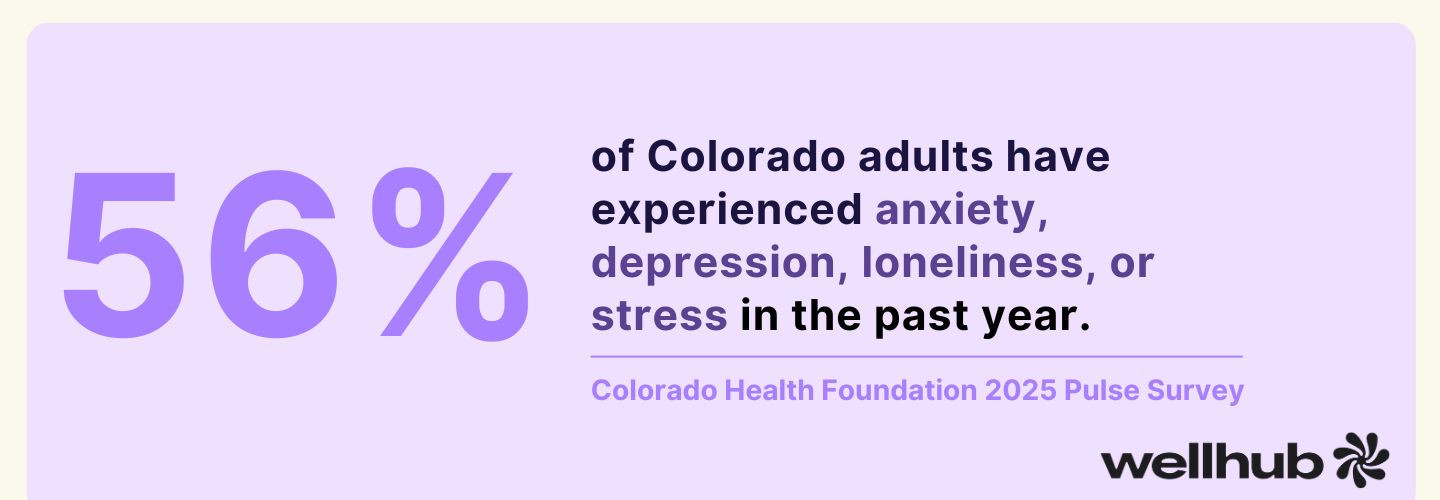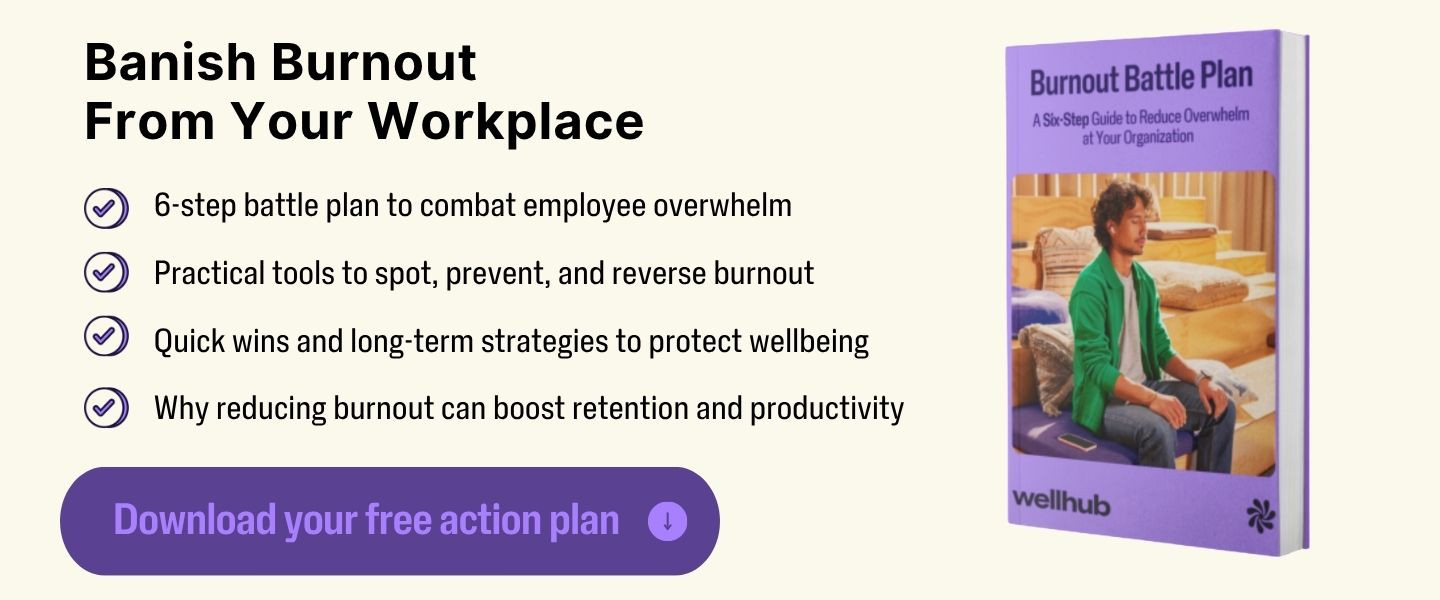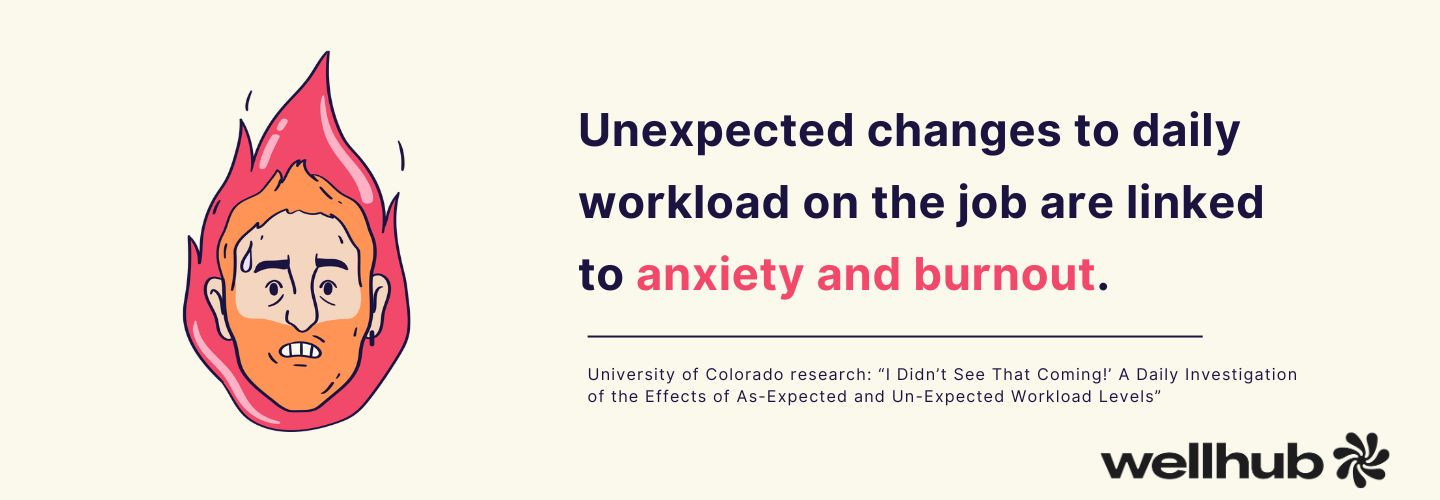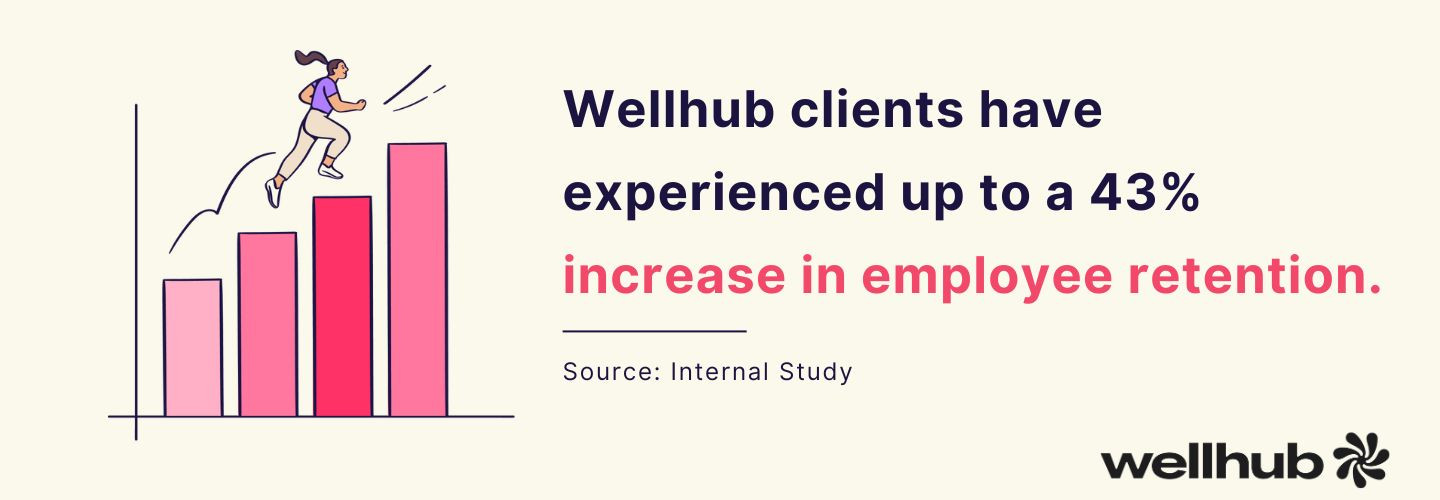Burnout in Colorado: What HR Leaders Must Do to Protect Teams
Last Updated Sep 17, 2025

Burnout is kicking down the office door in Colorado.
Across the state, nurses, teachers, and office workers are running on empty. And more than half of Coloradans report serious mental health strain. For many, the stress starts at work.
This is a wake-up call for HR leaders statewide. Burnout is dragging down productivity, inflating healthcare costs, and pushing top talent to the edge.
But things can change. Colorado workers are already carving out ways to recover and recharge. And those behaviors reveal exactly how HR leaders can help.
Unlock the tools Colorado employees are actually using to create a burnout buffer that works.

The State of Burnout in Colorado
Burnout in Colorado is affecting workers across industries and demographics. More than half of adults in Colorado (56%) say they’ve experienced anxiety, depression, loneliness, or stress in the past year. And for many, the source is no mystery: About 10% point directly to workplace issues as the top driver of their strain.
The weight of this strain shows up in powerful ways. The Colorado Health Access Survey found that more than one in four residents report poor mental health on at least eight days each month — the highest level the state has ever recorded.

It’s no surprise, then, that nearly six in ten residents (59%) believe mental health is an “extremely serious” issue across the state.
Some groups carry even more of this burden. More than a third of adults 18 to 50 are more than one-third poor mental health, but for LGBTQ+ Coloradans, the numbers are even starker: 54% report poor mental health, nearly double the rate of their straight and cisgender peers.
These are so much more than statistics. These are the colleagues, friends, and neighbors we rely on most.
Fortunately, with awareness comes opportunity. By addressing the factors driving stress, HR leaders in Colorado can make a measurable difference in the wellbeing of their teams.
What’s Fueling Burnout in Colorado Workplaces
Burnout grows when everyday pressures start piling up faster than people can manage them. In Colorado, those pressures are coming from every direction.
- Rising cost of living. Nearly nine in ten Coloradans (89%) say the cost of living is an extremely serious problem; 84% said the same for housing costs. When basics like groceries and housing strain budgets, and that financial stress follows employees into the workplace. Colorado’s suicide rate among construction workers is nearly double the average rate in other industries, for example. These workers report high stress, including stress from financial insecurity due to seasonal labor.
- Healthcare access gaps. Even when employees want support, it’s not always there. In 2023, 17% of Coloradans said they couldn’t get the mental health care they needed, most often because no appointments were available. On top of that,21% postponed care in the past year. Without timely support, stress lingers longer and recovery feels out of reach.
- Workload and staffing shortages. Take nurses as an example. In Colorado, they are carrying some of the heaviest patient loads in the nation, while nearly half of educators are considering leaving the profession.
All of this adds up to a workforce that’s strained financially, emotionally, and physically. HR leaders may not be able to lower housing costs or expand appointment availability, but they can create workplace systems that offer relief: benefits that ease stress, policies that support flexibility, and cultures that encourage recovery.

Why Burnout is a Business Problem
It’s easy to think of burnout as something individual employees need to “manage” with more rest, better boundaries, or a weekend away. But the costs of failing to deliver structural support quickly degrades a company’s bottom line.
- Retention risk. Employees are paying attention to how their organizations prioritize wellbeing. In fact, 66% of CEOs say their people would consider leaving if they didn’t see wellbeing taken seriously. With many Colorado workers already eyeing the exit, neglecting wellbeing will send talent walking.
- Productivity loss. Burnout drains performance. Nine out of 10 employees say their mental and physical wellbeing impacts how productive they are at work. Poor wellbeing makes it harder to focus, collaborate, and perform at their best.
- Healthcare costs. Stress and exhaustion carry a financial price tag, too. Sixty-eight percent of CEOs say wellness programs help reduce healthcare costs. When burnout goes unaddressed, claims rise, sick days increase, and premiums climb. The reverse is also true: invest in wellbeing, and costs begin to stabilize.
The takeaway? Burnout isn’t just hard on people — it’s hard on business.
But the flip side is encouraging: by treating burnout as an organizational issue, HR leaders in Colorado have an opportunity to strengthen retention and boost productivity.

A Solution for Colorado Businesses
When it comes to fighting burnout, Colorado employees don’t need another generic perk. They need a benefit that adapts to their lives. That’s where Wellhub comes in.
Wellhub is an all-in-one employee wellbeing platform that connects your people to hundreds of fitness and wellness partners across Colorado — and thousands beyond. One simple membership gives employees the freedom to choose what they need in the moment: a high-energy gym session, a restorative yoga class, a cycling workout, or even meditation and mindfulness resources.

And Colorado employees are already showing how powerful that choice can be. Wellhub members in the state recharge at Life Time and 24 Hour Fitness for full-service fitness, find community in high-intensity classes at F45 and OrangeTheory. They balance their stress with yoga, Pilates, or cycling at CorePower Yoga and Colorado Athletic Club. Many mix these activities week to week, building holistic routines that strengthen both body and mind.
For companies, the payoff is clear — and it’s measurable:
- Higher engagement: Employees who use Wellhub engage more because they actually love the options. In fact, two in three of Wellhub members didn’t have a gym membership before joining, proving that Wellhub opens doors to wellbeing for people who wouldn’t otherwise participate.
- Better retention: Wellbeing is tied directly to loyalty: Wellhub clients have seen an up to 43% improvement in employee retention.
- Lower healthcare costs: Wellness programs work: 68% of CEOs say these programs help reduce healthcare costs. Wellhub makes those benefits accessible at scale — client healthcare costs have dropped by more than a third.
With Wellhub, HR leaders can give employees the flexibility they’re asking for — and see meaningful improvements in engagement, retention, and costs as a result.
⛰️Discover how Wellhub powers mountain-style fitness.
Tackling Burnout in Colorado with Employee Wellbeing
Colorado employees are facing heavy stress from rising costs, limited healthcare access, and overwhelming workloads. These pressures are driving burnout, draining productivity, and pushing people to consider leaving their jobs.
An employee wellbeing program gives people real tools to manage stress and stay balanced. Wellhub connects employees to thousands of gyms, studios, and digital wellness options so they can choose what works best for their lives. Companies that prioritize wellbeing see measurable impact — 66% of CEOs say their people are more likely to stay when wellbeing is part of the culture, and 68% report lower healthcare costs.
Speak with a Wellhub Wellbeing Specialist to help your employees fight burnout and stay engaged.

Company healthcare costs drop by up to 35% with Wellhub*
See how we can help you reduce your healthcare spending.
Category
Share

The Wellhub Editorial Team empowers HR leaders to support worker wellbeing. Our original research, trend analyses, and helpful how-tos provide the tools they need to improve workforce wellness in today's fast-shifting professional landscape.
Subscribe
Our weekly newsletter is your source of education and inspiration to help you create a corporate wellness program that actually matters.
Subscribe
Our weekly newsletter is your source of education and inspiration to help you create a corporate wellness program that actually matters.
You May Also Like

Corporate Wellness Trends HR Must Know for 2026 | Wellhub
See the top 2026 wellness trends shaping performance, retention, and culture—plus how HR can build a unified, ROI-driven wellbeing strategy.

Wellness Points Programs: Boost Employee Health & Engagement | Wellhub
Turn your workplace wellness strategy around with a points program that rewards healthy behavior with perks, from extra time off to gift cards.

Employee Financial Wellness Programs: Ultimate HR Guide | Wellhub
Create an effective financial wellness program that supports your employees in their financial needs, boosting productivity and retention.